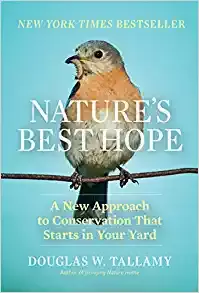AuthorLyn Chimera is a Master Gardener, consultant and lecturer. Archives
May 2023
Categories |
Back to Blog
December '22 Tips12/1/2022
*|MC_PREVIEW_TEXT|*
0 Comments
Read More
Back to Blog
Give the Gift of a Book12/1/2022  By: Lyn Chimera Many of us are trying to decide what to buy for friends and family over the holidays. A book is always appreciated and often something people don’t buy for themselves. On the subject of gardening there are books on any topic you can imagine from trees to improving soil and everything in between. The following are some recommendations. The Living Landscape, by Doug Tallamy and Rick Darke is subtitled Designing for Beauty and Biodiversity in the Home Garden. Gardeners who want a landscape that supports nature and is beautiful at the same time will love this book. By combining the insights of two outstanding authors, this book offers a model that anyone can follow. The book outlines the strategies for making and maintaining a diverse, layered landscape from ground level to trees. The book includes providing for outdoor rooms, areas for children and pets, incorporates fragrance and edible plants all while providing cover, shelter and sustenance for wildlife. On top of all the excellent information the book is filled with beautiful photographs by Rick Dark who has won awards for his photography. This can be a coffee table book as well as an informational one. One of the most useful sections is at the end where they list plants by region showing growing needs and what they help in nature. Doug Tallamy had changed the conversation about the importance of home landscaping in supporting pollinators, birds and the plants and insects they need to survive. His book Bringing Nature Home is a must read as it describes the relationship between what you plant and how it matters to nature. It also includes an extensive section showing which plants support butterflies and moths as well as a regional listing of natives that have a benefit for wildlife. His second book Nature’s Best Hope covers a new approach to conservation that begins in our yards. He calls it “Homegrown National Parks”. His message is you don’t have to plant all natives but if everyone planted some the overall effect would be so beneficial to nature, beneficial insects and birds. The decline in honeybees has been in the news for years. The book Honeybee Democracy, by Thomas Seeley will give you an insightful look at the complex life of honeybees. Based on scientific studies, Seeley has written a very good and readable book about how bees operate and function as a group. We have a lot to learn from their “democratic” methods of decision making. You will never look at honeybees in the same way again. If you’re looking for a general how to book on gardening, The Well-Tended Perennial Garden, by Tracy DiSabato-Aust is excellent. This is one of the most useful and practical books for gardeners at all levels. There are chapters on basic perennial garden planning and maintenance, pruning and an encyclopedia of perennials that includes information on how to grow and maintain each plant. The appendix includes a perennial maintenance manual and listings of month-by-month maintenance suggestions. This book also includes lots of time and work saving techniques. It’s a go to book for basic and advanced perennial gardeners. If a book that gives detailed information on selected plants is what you’re looking for, Spring Wildflowers of the North East and Summer Wildflowers of the North East, by Carol Gracie would be perfect. In addition to the most amazing photographs these books educate the reader about each plant, its history, uses, propagation and growing conditions along with interesting facts. There aren’t just a few paragraphs about each plant but multiple pages. Even advanced gardeners will learn from these books. Anyone interested in trees would enjoy Finding the Mother Tree, Discovering the Wisdom of the Forest, by Suzanne Simard. This book is basically a story about her journey into the life of trees and coming to understand how they function. Simard brings us to the intimate world of trees, in which she brilliantly shows us that trees are not simply the source or timber or pulp but are a complicated circle of life. Trees in a healthy forest support each other and even communicate through underground networks. It’s fascinating and reads like a novel. There are so many books available about gardening and nature that you’re sure to find just the right gift – for yourself or others. |

 RSS Feed
RSS Feed


